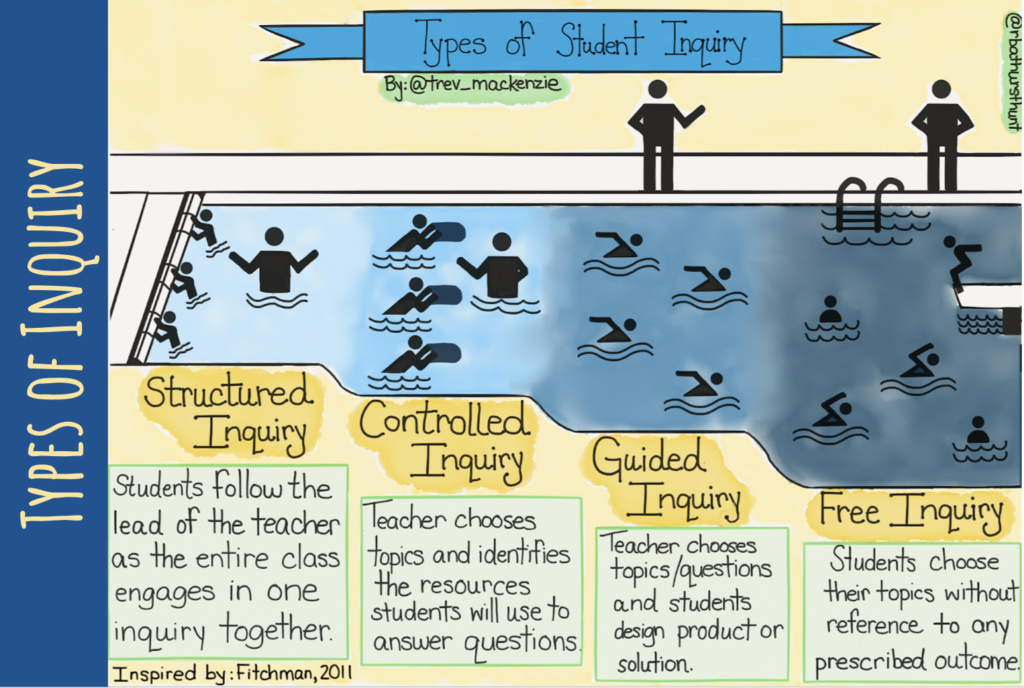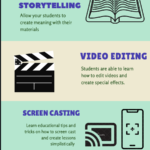To begin this blog post I would firstly like to share how much I value Inquiry-based Learning in education. I had the opportunity in EDCI 336 to attend a webinar with Jeff Hopkins (Founder of Pacific School of Innovation and Inquiry) and Trevor MacKenzie (English teacher and author of the Inquiry Mindset). These two individuals transformed my understanding of education and inspired my future instructional practices.
Inquiry-based learning goes beyond the traditional idea of a classroom and instead begins to shape student’s minds to the unlimited possibilities of where learning can take them (Wolpert-Gawron, 2016). Inquiry-based learning is the idea of creating curiosity and inspiring students to develop questions. Students take ownership of their own learning and decide how and what they learn. In 2014, Jeff Hopkins quotes, “Education is not the filling of a pale, but rather the lighting of a flame”, and explains how learning should come within us, rather than outside us. Inquiry-based learning forms innate human curiosity, and for learners to make sense of the world around them and encourage diverse thinking (Wolpert-Gawron, 2016).
I encourage everyone, to take the time to watch this Ted Talk, featuring Jeff Hopkins. He explains how to take the next steps towards an Inquiry-based education, and explains the student’s beneficial outcomes of this level of instruction.
To embed Inquiry-based learning in our education, the system needs to make a shift towards knowing, rather than knowing about (Hopkins, 2014). Constructive alignment is the idea that learning is not about how teachers teach, or who the learner is, rather it is what the learners do and how they construct knowledge (James, 2021). Thus, it is essential for teachers to use inquiry to develop the learner’s ability to construct knowledge and gain self-responsibility. Inquiry-based learning engineers this form of thinking and transforms the classroom towards the student’s ideas, thoughts, and questions (MacKenzie, 2021). Students have the opportunity to take charge of their own learning in the classroom and dictate their own knowledge construction.
Trevor MacKenzie discussed the importance of 4 different types of Inquiry, structured, controlled, guided, and free. Here is a photo that helps explain the differences (MacKenzie, 2021).

Teachers may find it challenging to start using inquiry-based learning in their classrooms as it involves preconditioning and preparing the student’s mentality towards inquiry. Therefore, the gradual release of responsibility (GRR model) is used to effectively transition the students/classroom towards inquiry-based learning. Over time the teacher becomes less involved, allowing the students to have more control and choice in their ideas. Trevor shares the benefits of students’ achievement when learners work on areas of academia they are interested in (MacKenzie, 2021). There are also many important characteristics (below image) of an inquiry-based classroom, and if all the values are met the student’s learning potential becomes fulfilled (MacKenzie, 2021). The student’s drive to learning comes from within and use self-discovery to develop their knowledge and create meaningful connections (Hopkins, 2021).

This way of knowledge distribution prepares learners for higher education and life after university. We transition the students from the interpretation of material, towards learning that involves risk-taking, curiosity, and goal-setting (Wolpert-Gawron, 2016). Teachers would begin to prepare students for success and produce lifelong learners.
Blueprint Topic
I believe that this form of education is beneficial and rewarding when done correctly, and needs to be introduced slowly (GRR Model), so learners can reach their full potential. I believe that this learning design would correlate with our blueprint topic (descriptive language), as we would be able to structure the lesson around the student’s discovery and questions surrounding their curiosity on our topic. This would also be an effective way to introduce multiple areas of study, especially at an elementary level. However, when designing a learning design blueprint or lesson plan it is fairly challenging to incorporate inquiry-based lessons at a young age. I believe it would be beneficial, yet the students must be accustomed to an inquiry-based education beforehand. It is difficult to plan a topic for students without prior knowledge of the classroom structure or learning outcomes of the students. Our pod has the intention of using this blueprint in future practicums for our program, Bachelor of Elementry Education, and is choosing to take a more directive and cooperative approach for planning our blueprint topic. Therefore, our blueprint topic supports cooperative learning, direct instruction, and experimental approaches to better equip the students with successful learning in our given topic.
References
MacKenzie, T. (n.d.). Inquiry Mindset Assessment Edition. Tmac. https://www.trevormackenzie.com/index
Pacific School of Innovation and Inquiry. (2021). https://learningstorm.org
Wolpert-Gawron, H. (2016). What the Heck Is Inquiry-Based Learning? Edutopia. https://www.edutopia.org/blog/what-heck-inquiry-based-learning-heather-wolpert-gawron
Hopkins, J. (2014). Education as if People Mattered [Video]. TEDxVictoria. https://www.youtube.com/watch?v=5O5PK6LsymM
Hopkins, J. (2021). Pacific School of Innovation and Inquiry. Personal Communication EDCI 336.
MacKenzie, T. (2021). Inquiry-Based Learning. Personal Communication EDCI 336.
James, H. (2021). What Is Learning? Learning Design I. https://edtechuvic.ca/edci335/what-is-learning/



